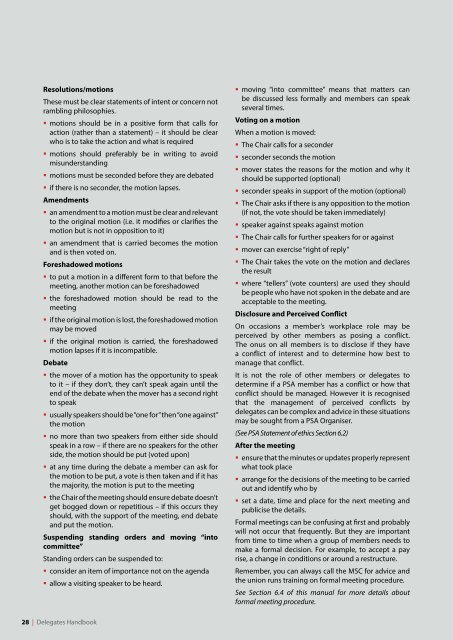Delegates Handbook
delegates_handbook
delegates_handbook
You also want an ePaper? Increase the reach of your titles
YUMPU automatically turns print PDFs into web optimized ePapers that Google loves.
Resolutions/motions<br />
These must be clear statements of intent or concern not<br />
rambling philosophies.<br />
• motions should be in a positive form that calls for<br />
action (rather than a statement) – it should be clear<br />
who is to take the action and what is required<br />
• motions should preferably be in writing to avoid<br />
misunderstanding<br />
• motions must be seconded before they are debated<br />
• if there is no seconder, the motion lapses.<br />
Amendments<br />
• an amendment to a motion must be clear and relevant<br />
to the original motion (i.e. it modifies or clarifies the<br />
motion but is not in opposition to it)<br />
• an amendment that is carried becomes the motion<br />
and is then voted on.<br />
Foreshadowed motions<br />
• to put a motion in a different form to that before the<br />
meeting, another motion can be foreshadowed<br />
• the foreshadowed motion should be read to the<br />
meeting<br />
• if the original motion is lost, the foreshadowed motion<br />
may be moved<br />
• if the original motion is carried, the foreshadowed<br />
motion lapses if it is incompatible.<br />
Debate<br />
• the mover of a motion has the opportunity to speak<br />
to it – if they don’t, they can’t speak again until the<br />
end of the debate when the mover has a second right<br />
to speak<br />
• usually speakers should be “one for” then “one against”<br />
the motion<br />
• no more than two speakers from either side should<br />
speak in a row – if there are no speakers for the other<br />
side, the motion should be put (voted upon)<br />
• at any time during the debate a member can ask for<br />
the motion to be put, a vote is then taken and if it has<br />
the majority, the motion is put to the meeting<br />
• the Chair of the meeting should ensure debate doesn’t<br />
get bogged down or repetitious – if this occurs they<br />
should, with the support of the meeting, end debate<br />
and put the motion.<br />
Suspending standing orders and moving “into<br />
committee”<br />
Standing orders can be suspended to:<br />
• consider an item of importance not on the agenda<br />
• allow a visiting speaker to be heard.<br />
• moving “into committee” means that matters can<br />
be discussed less formally and members can speak<br />
several times.<br />
Voting on a motion<br />
When a motion is moved:<br />
• The Chair calls for a seconder<br />
• seconder seconds the motion<br />
• mover states the reasons for the motion and why it<br />
should be supported (optional)<br />
• seconder speaks in support of the motion (optional)<br />
• The Chair asks if there is any opposition to the motion<br />
(if not, the vote should be taken immediately)<br />
• speaker against speaks against motion<br />
• The Chair calls for further speakers for or against<br />
• mover can exercise “right of reply”<br />
• The Chair takes the vote on the motion and declares<br />
the result<br />
• where “tellers” (vote counters) are used they should<br />
be people who have not spoken in the debate and are<br />
acceptable to the meeting.<br />
Disclosure and Perceived Conflict<br />
On occasions a member’s workplace role may be<br />
perceived by other members as posing a conflict.<br />
The onus on all members is to disclose if they have<br />
a conflict of interest and to determine how best to<br />
manage that conflict.<br />
It is not the role of other members or delegates to<br />
determine if a PSA member has a conflict or how that<br />
conflict should be managed. However it is recognised<br />
that the management of perceived conflicts by<br />
delegates can be complex and advice in these situations<br />
may be sought from a PSA Organiser.<br />
(See PSA Statement of ethics Section 6.2)<br />
After the meeting<br />
• ensure that the minutes or updates properly represent<br />
what took place<br />
• arrange for the decisions of the meeting to be carried<br />
out and identify who by<br />
• set a date, time and place for the next meeting and<br />
publicise the details.<br />
Formal meetings can be confusing at first and probably<br />
will not occur that frequently. But they are important<br />
from time to time when a group of members needs to<br />
make a formal decision. For example, to accept a pay<br />
rise, a change in conditions or around a restructure.<br />
Remember, you can always call the MSC for advice and<br />
the union runs training on formal meeting procedure.<br />
See Section 6.4 of this manual for more details about<br />
formal meeting procedure.<br />
28 | <strong>Delegates</strong> <strong>Handbook</strong>


